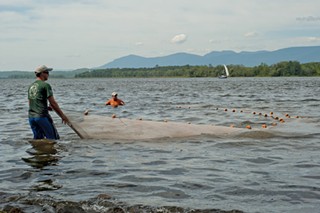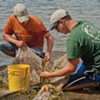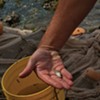Human activity over the past two centuries has pummeled the American shad. Of the original 138 distinct populations, only 68 survive, according to data compiled by marine biologists Karin Limburg and John Waldman. (Shad inhabiting West Coast rivers aren't native, but are derived from stock taken from the Hudson in the 1880s.) The damming of rivers, which blocked the fish from their spawning grounds, wiped out the shad on many rivers starting in the early and mid 19th century. Dams are ubiquitous; the only East Coast river without one is the Delaware (although the damming of its tributaries has impacted the shad). In the Hudson, shad originally traveled as far north as Glens Falls before the building of the Troy Dam. In The Riverkeepers by John Cronin and Robert K. Kennedy Jr., the legendary shad fisherman Everett Nack is quoted as saying he's observed shad "virtually bumping their heads on the federal dam."
Another blow was the building of the railroads, which destroyed much of the productive, riparian vegetation along the shoreline and also walled off the fish's access to streams. The dredging of the channel to the port of Albany was particularly devastating: The fill obliterated more than half of the marshy islands and shoals that were prime shad spawning grounds. Unfortunately, marine biologists said that destructive "hardening" of the shoreline continues, with each new riverside development nibbling away at the remaining fragments of habitat.
Net Loss
Overfishing has been a perennial problem in the 200-year history of the Hudson's shad fishery. To their detriment, shad, the largest member of the herring family, and its two cousins, the alewife and blueback herring, are remarkably easy to catch: During the spawning run, you simply set out a net—drift, anchored to the bottom, or attached to poles hammered into the river bottom. As early as the 1820s, according to McPhee in The Founding Fish, there were shortages of shad on the Hudson caused by oversized hauls of fish. By the mid 19th century, the state began regulating net lifts and stocking the river with shad from other states. Periodically, the stock would recover—then crash again. The huge influx of immigrants stepped up demand for such an easily and cheaply procured local food: In 1895, when the first shad assessment in the Hudson was made, 5,520 nets extending from Bay Ridge to Castleton caught a total of 1,868,547 fish weighing more than 1.8 million kilograms. By 1910, the fishery had collapsed, according to an article in the Environmental History of the Hudson River (SUNY Press, 2011) by Limburg, Robert Daniels, and Robert Schmidt.
By 2009, only six fisheries were left, and the last harvest of shad in the Hudson amounted to 3,792 fish, according to the DEC. Not so many years ago, that would have been considered a modest catch for a single fisherman, let alone an entire fishery. Garry Nack, son of Everett, said when he, his brother, and a friend would go out in their boats near Catskill and pull in their 500-foot-long net, attached to 13-foot-long buoy strings, they'd catch 200 to 300 shad at a time. "I'd imagine some seasons at the peak maybe you'd catch 10,000 fish," he says. Nack recalled that he first noticed the declining numbers in 2005. Much of the shad they caught wasn't the sweet-tasting American shad, but "gizzard shad," a short, fat, weed-eating fish no one would buy.
As recently as the 1980s, the Hudson "had lots of fish," says Kathy Hattalla, one of two marine biologists at the DEC's Hudson River Fisheries unit who oversee shad. Strangely, in the mid 20th century, when the Hudson was choked with pollution, the shad fared fairly well. One factor in their favor was the timing of their migration, which enabled both the spawning fish and the young to avoid the vast, deadly pools of sewage-laden, oxygen-deprived water that formed at Albany and New York City in the summer.
Easy Prey
Water intakes by power plants have been another significant killer of fish, although there's been some progress on this front: 10 years ago, a power plant near Albany, renamed the Bethlehem Energy Center, switched to a closed cooling system that's drastically reduced fish mortality. However, Indian Point continues to take in over two billion gallons of river water a day, which kills larger fish by impinging them against the intake screens and sucks in millions of eggs, larvae, and small fish.














